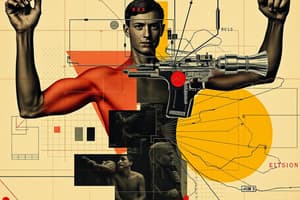Podcast
Questions and Answers
Which muscle primarily acts as an antagonist during elbow flexion when the biceps brachii is the agonist?
Which muscle primarily acts as an antagonist during elbow flexion when the biceps brachii is the agonist?
- Biceps brachii
- Deltoid
- Triceps brachii (correct)
- Brachialis
During a pelvic curl exercise, which sequence of vertebral movement is typically emphasized?
During a pelvic curl exercise, which sequence of vertebral movement is typically emphasized?
- Simultaneous movement of all regions
- Thoracic, lumbar, cervical
- Lumbar, thoracic, cervical (correct)
- Cervical, thoracic, lumbar
In the context of muscle force couples, what is the combined action of the deltoid muscle's anterior, middle, and posterior fibers?
In the context of muscle force couples, what is the combined action of the deltoid muscle's anterior, middle, and posterior fibers?
- Elbow Flexion
- Shoulder abduction (correct)
- Shoulder adduction
- Horizontal adduction
How does the 'Hundred' exercise primarily challenge the abdominal muscles?
How does the 'Hundred' exercise primarily challenge the abdominal muscles?
Which muscle is the prime mover in hip flexion, often targeted in exercises like leg lifts?
Which muscle is the prime mover in hip flexion, often targeted in exercises like leg lifts?
What is the primary focus when performing the 'Spine Stretch Forward' exercise?
What is the primary focus when performing the 'Spine Stretch Forward' exercise?
During the 'Rolling Like a Ball' exercise, what is the main objective concerning the spine?
During the 'Rolling Like a Ball' exercise, what is the main objective concerning the spine?
In the 'Crisscross' exercise, what is the intended movement pattern of the upper body?
In the 'Crisscross' exercise, what is the intended movement pattern of the upper body?
Flashcards
Iliopsoas Muscle
Iliopsoas Muscle
A key muscle group that includes the iliacus and psoas major, responsible for hip flexion.
Sartorius Muscle
Sartorius Muscle
The longest muscle in the body, aiding in hip flexion, abduction, and lateral rotation.
Rectus Femoris
Rectus Femoris
Part of the quadriceps group, it extends the knee and flexes the hip.
Rotator Cuff
Rotator Cuff
Signup and view all the flashcards
Pelvic Curl
Pelvic Curl
Signup and view all the flashcards
Spine Twist Supine
Spine Twist Supine
Signup and view all the flashcards
One-Leg Stretch
One-Leg Stretch
Signup and view all the flashcards
Teaser
Teaser
Signup and view all the flashcards
Study Notes
Muscles at Work
- Muscles contract, shorten, lengthen, or stay the same length depending on the forces applied and resistance.
- Muscle contractions are classified as dynamic (isotonic) or static (isometric).
- Dynamic contractions involve visible joint movement and can be concentric (shortening) or eccentric (lengthening).
- Concentric contractions occur in the same direction as the muscle's action.
- Eccentric contractions occur in the opposite direction of the muscle's action. Often used for deceleration.
- Static (isometric) contractions result in no visible joint movement; the force of the muscle is counteracted by an opposing resistance.
Muscle Roles
- Movers (agonists) produce the desired movement at a joint, and can have primary or secondary roles.
- Secondary muscles are assistant movers, helping primary muscles.
- Antagonists oppose the movement of the agonist.
- Synergists work with prime movers to neutralize unwanted secondary actions.
- Stabilizers contract isometrically to support or stabilize parts of the body.
Muscles as Force Couples
- Force couples consist of muscles acting in the same direction, often across a joint.
- Examples are opposing muscles creating rotation or preventing unwanted motion.
Studying That Suits You
Use AI to generate personalized quizzes and flashcards to suit your learning preferences.




